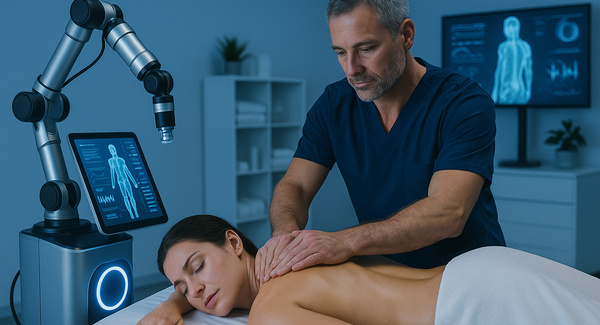The Future of Touch: How Technology is (and Isn’t) Changing Massage Therapy

Massage therapy has long been rooted in the art of human touch—a deeply personal experience blending skill, empathy, and intuition. For thousands of years, healing touch has remained fundamentally unchanged: skilled hands working with the body's natural systems to promote wellness, reduce pain, and restore balance.
Yet, as we advance deeper into the digital age, the wellness industry is experiencing a technological revolution that's transforming how massage therapy is delivered, managed, and experienced. From AI-powered booking systems that streamline operations to cutting-edge equipment that enhances therapeutic outcomes, technology is creating new possibilities for both practitioners and clients.
This transformation raises important questions: How can we harness innovation to improve massage therapy without losing its essential human element? What technologies are truly enhancing the therapeutic experience, and which are merely novelties? Most importantly, how do we ensure that in our rush to embrace the future, we don't lose sight of what makes massage therapy so profoundly healing—the irreplaceable power of compassionate human touch.
Technology in Massage Therapy: Innovation Meets Human Touch
The massage therapy industry has traditionally been slow to adopt new technologies, and for good reason. The profession is built on personal connection, intuitive touch, and the subtle art of reading the body's responses. However, recent global shifts toward digital health solutions, remote services, and personalised wellness have accelerated technology adoption across the industry.
This digital transformation isn't just about keeping up with trends—it's about addressing real challenges that massage therapists and clients face daily. Scheduling conflicts, accessibility barriers, inconsistent treatment tracking, and administrative burdens have long plagued the industry. Technology offers solutions to these problems while potentially enhancing the therapeutic experience itself.
What makes this evolution particularly interesting is how it's happening on multiple fronts simultaneously: operational technologies that improve business efficiency, therapeutic technologies that enhance treatment outcomes, and communication technologies that strengthen the therapist-client relationship.
AI and Digital Tools: Revolutionising Client Engagement and Operations
Smart Booking and Scheduling Systems
Gone are the days when massage therapy bookings required phone tag between clients and receptionists. Modern AI-powered scheduling systems have transformed how appointments are managed, offering 24/7 availability that works around both therapist and client schedules.
These intelligent systems do far more than simple calendar management. They learn client preferences, track treatment history, and can suggest optimal appointment times based on individual patterns. For example, suppose a client typically books deep-tissue massage sessions on Monday evenings after a stressful work week. In that case, the system can proactively suggest similar time slots and even send gentle reminders about the benefits of regular treatment.
Advanced booking platforms integrate with therapists' calendars, automatically blocking out unavailable times and managing complex scheduling scenarios like group bookings or extended treatment sessions. They handle cancellations gracefully, automatically offering alternative times and managing waitlists to maximise therapist utilisation.
For mobile massage services, these systems become even more sophisticated, calculating travel times, optimising route planning, and ensuring therapists arrive prepared with everything needed for each specific client and treatment type.
Virtual Consultations and Telehealth Integration
The integration of telehealth technologies has opened new possibilities for initial consultations, follow-up care, and ongoing client support. Virtual consultations enable therapists to conduct thorough intake interviews, assess posture and movement patterns, and discuss treatment goals before the first hands-on session.
This preliminary connection serves multiple purposes: it builds rapport between therapist and client, allows for more efficient use of hands-on session time, and helps therapists prepare appropriate treatment plans and equipment. For clients in remote areas or those with mobility challenges, virtual consultations can make massage therapy accessible when it might otherwise be impossible.
Post-session follow-ups via video calls or secure messaging platforms help therapists monitor progress, adjust treatment plans, and provide homework exercises or self-care recommendations. This continuity of care extends the therapeutic relationship beyond the treatment room, leading to improved outcomes and stronger client relationships.
Personalised Wellness Plans and Data Analytics
Modern massage therapy practices are beginning to leverage data analytics to create truly personalised wellness experiences. By tracking treatment history, client feedback, pain levels, and progress metrics, AI systems can help therapists identify patterns and optimise treatment approaches.
These systems might notice that a particular client responds better to certain techniques during specific times of the month, or that their stress levels correlate with particular work schedules or life events. This data-driven approach doesn't replace therapist intuition—instead, it enhances it by providing objective insights that might not be immediately apparent.
Integration with wearable devices and health apps can provide additional context about client wellness. Sleep patterns, activity levels, and stress indicators from fitness trackers can inform treatment planning and help therapists understand the broader context of their clients' health and wellness needs.
Advanced Equipment Enhancing Therapeutic Outcomes
Percussive and Vibration Therapy Devices
The rise of percussive therapy devices has been one of the most visible technological advances in massage therapy. These handheld tools deliver rapid, targeted pulses to muscle tissue, providing benefits that complement traditional massage techniques.
Professional-grade percussive devices offer variable speeds, interchangeable heads for different muscle groups, and sophisticated motors that maintain consistent pressure even against resistant tissue. When used skillfully by trained therapists, these tools can enhance treatment effectiveness, reduce therapist fatigue, and provide precise treatment for specific problem areas.
However, the key word here is "skillfully." These devices are most effective when integrated thoughtfully into comprehensive treatment plans, not used as replacements for traditional massage techniques. The best practitioners use them strategically—perhaps to warm up tissue before manual work, or to provide targeted treatment to specific trigger points.
Thermal and Infrared Technologies
Heat therapy has always been part of massage practice, but modern thermal technologies are taking it to new levels. Infrared therapy tables and handheld devices can penetrate deeper into tissue than traditional heating pads, promoting circulation and preparing muscles for manual treatment.
Some massage tables now feature built-in heating elements with precise temperature control, allowing therapists to maintain optimal warmth throughout the session. Far-infrared technology claims to offer therapeutic benefits beyond simple heat; however, practitioners should rely on evidence-based applications rather than marketing claims.
Cryotherapy tools are also finding their place in massage therapy practices, particularly for sports massage and injury recovery. The contrast between heat and cold can enhance circulation and reduce inflammation when applied skillfully.
Biofeedback and Monitoring Technologies
Emerging biofeedback technologies allow therapists to monitor client responses in real-time during treatment. Heart rate variability monitors, muscle tension sensors, and other devices can provide objective feedback on how the body responds to different techniques.
While still in early adoption phases, these technologies show promise for enhancing treatment precision and helping therapists understand which approaches are most effective for individual clients. They're particularly valuable for training new therapists, providing objective feedback on the effectiveness of their techniques.
Virtual Reality and Environmental Enhancement
Some forward-thinking massage therapy practices are experimenting with virtual reality and immersive environment technologies to enhance the relaxation experience. VR headsets can transport clients to calming natural environments, while sophisticated sound and lighting systems create multi-sensory experiences that deepen relaxation.
These technologies are particularly promising for clients dealing with anxiety, trauma, or chronic pain, where traditional relaxation techniques might be insufficient. However, they require careful implementation to ensure they enhance rather than distract from the therapeutic touch experience.
The Irreplaceable Human Element
Intuition and Adaptability in Real-Time
Despite all technological advances, the core of massage therapy remains fundamentally human. The ability to sense subtle changes in tissue quality, adjust pressure based on immediate feedback, and intuitively know when to modify approach cannot be replicated by machines.
Experienced massage therapists develop an almost sixth sense about their clients' needs. They can sense when someone is holding emotional tension, detect when a particular area needs gentler or firmer touch, and adapt their entire approach based on hundreds of micro-signals that current technology cannot detect or interpret.
This intuitive responsiveness extends beyond physical touch to emotional presence. The ability to hold space for a client's healing process, to provide the right amount of conversation or silence, and to create a sense of safety and trust—these human qualities remain irreplaceable.
Ethical Boundaries and Professional Judgment
Massage therapy involves intimate physical contact and requires constant attention to ethical boundaries, consent, and client comfort. Human therapists can read verbal and non-verbal cues, adjust their approach when someone seems uncomfortable, and maintain appropriate professional boundaries throughout treatment.
This is particularly crucial when working with trauma survivors, clients with body image issues, or those dealing with chronic pain conditions. The ability to recognize when someone needs a different approach, when to pause treatment, or when to refer to other healthcare providers requires human judgment that cannot be automated.
Professional ethics in massage therapy are complex and situational. Every client interaction requires decisions about appropriate touch, communication, and treatment boundaries. These decisions require not just technical knowledge but wisdom, empathy, and the ability to navigate complex human emotions and needs.
Building Therapeutic Relationships
Perhaps most importantly, effective massage therapy often depends on the therapeutic relationship between practitioner and client. This relationship—built on trust, consistency, and genuine care for the client's wellbeing—provides the foundation for effective treatment.
Clients often share personal information, discuss emotional challenges, and process stress and trauma during massage sessions. The therapist's ability to listen, offer appropriate support, and maintain professional boundaries while showing genuine care creates a healing environment that extends far beyond the physical benefits of massage.
This relationship develops over time through consistent, compassionate care. Regular clients often report that their relationship with their massage therapist is an important part of their overall wellness support system—something that cannot be replicated through technology alone.
Integration Strategies: Best Practices for Tech-Enhanced Massage Therapy
Enhancement, Not Replacement
The most successful integration of technology in massage therapy follows a clear principle: technology should enhance human capabilities, not replace them. The goal is to utilize tools and systems that enable therapists to deliver better care, work more efficiently, and achieve superior outcomes for their clients.
This means carefully evaluating new technologies based on their ability to support therapeutic goals rather than adopting them simply because they're new or impressive. Questions to ask include: Does this technology help me provide better care? Does it improve client outcomes? Does it allow me to work more sustainably? Does it enhance the therapeutic relationship or distract from it?
Privacy, Security, and Data Protection
As massage therapy practices become more digital, protecting client privacy and data security becomes increasingly important. Any technology that collects, stores, or transmits client information must comply with healthcare privacy regulations and maintain the highest security standards to ensure the confidentiality, integrity, and security of this information.
This includes not just basic information like contact details and appointment history, but also health information, treatment notes, and any data collected through biofeedback or monitoring devices. Practices must have clear policies about data collection, storage, and sharing, and clients should always understand how their information will be used.
Cloud-based systems offer convenience and accessibility but require careful vetting to ensure they meet healthcare security standards. Local data storage may be more secure but requires robust backup and disaster recovery plans.
Training and Professional Development
Successfully integrating technology into massage therapy practice requires ongoing education and training. Therapists need to understand not just how to use new tools and systems, but when and why to use them for optimal therapeutic benefit.
This includes both technical training on specific devices or software and broader education about evidence-based applications of technology in massage therapy. Professional organizations and continuing education providers are now offering courses specifically focused on integrating technology into massage practice.
It's also essential for therapists to maintain their core manual skills while adopting new technologies. The goal is to become more skilled and effective practitioners, not to become dependent on technology as a substitute for fundamental therapeutic abilities.
Client Education and Expectation Management
When introducing new technologies into massage therapy practice, clear client communication is essential. Clients need to understand what technologies will be used, how they enhance treatment, and what benefits they can expect to receive.
Some clients may be enthusiastic about high-tech approaches, while others prefer traditional methods. Successful practices offer options, allowing clients to choose their comfort level with technology integration. The key is ensuring that technology enhances the experience for those who want it without alienating those who prefer simpler approaches.
Informed consent becomes more complex when technology is involved. Clients should understand what data is being collected, how devices work, and any potential risks or limitations associated with them. This transparency fosters trust and enables clients to make informed decisions about their care.
Case Studies: Technology Integration in Practice
Urban Wellness Center: Comprehensive Digital Integration
Metro Massage Therapy in downtown Seattle has successfully integrated multiple technologies to enhance both client experience and operational efficiency. Their approach includes AI-powered scheduling, comprehensive client health tracking, and selective use of therapeutic devices.
The practice uses a sophisticated booking system that learns client preferences and automatically suggests appointment times, treatments, and even music preferences based on previous sessions. Clients can book, reschedule, and pay through a mobile app that also provides access to post-session care recommendations and exercise videos.
Therapists use tablets to access client history, treatment notes, and real-time scheduling updates. The system integrates with professional-grade percussive devices and thermal therapy tools, automatically logging which devices were used and for how long during each session.
The result has been improved client satisfaction, reduced no-shows, and increased therapist efficiency. However, the practice maintains that technology success depends on their therapists' continued focus on manual skills and client relationships.
Rural Mobile Practice: Technology Enabling Access
Mountain Mobile Massage serves clients across rural Colorado, using technology to make massage therapy accessible in underserved areas. Their approach focuses on communication technologies and efficient routing rather than high-tech treatment devices.
The practice uses GPS-enabled scheduling software that optimizes routes and ensures therapists arrive prepared for each client's specific needs and space constraints. Virtual consultations help new clients prepare for their sessions and facilitate follow-up care between visits.
Simple but effective client tracking helps therapists remember preferences and progress across multiple visits, while secure messaging allows for ongoing communication and appointment adjustments. The focus remains on fundamental massage skills enhanced by smart logistics and communication.
Future Trends and Emerging Technologies
Artificial Intelligence and Machine Learning
The next generation of AI applications in massage therapy will likely focus on pattern recognition and predictive analytics. Systems that can analyze treatment outcomes across large client populations may identify optimal treatment protocols for specific conditions or client types.
Machine learning algorithms might eventually help therapists predict which techniques will be most effective for individual clients based on their health history, responses to previous treatments, and even genetic factors. However, these systems will need to be carefully validated and should always support rather than replace clinical judgment.
Wearable Technology Integration
As wearable devices become more sophisticated, integration with massage therapy practice will likely deepen. Continuous monitoring of stress levels, sleep quality, and physical activity could provide valuable context for treatment planning and progress tracking.
Real-time biofeedback during massage sessions might become more common, helping both therapists and clients understand how different techniques affect the nervous system, muscle tension, and overall stress response.
Haptic Technology and Remote Touch
Emerging haptic technologies might eventually enable some forms of remote massage therapy, though this remains highly experimental. More practically, haptic feedback systems could enhance therapist training by providing objective feedback about pressure, rhythm, and technique consistency.
Sustainable and Smart Practice Technologies
Environmental sustainability is becoming increasingly important in healthcare, and massage therapy practices are beginning to adopt green technologies. Intelligent building systems that optimize heating, cooling, and lighting based on appointment schedules can reduce energy consumption while maintaining optimal therapeutic environments.
Digital documentation and communication systems reduce paper consumption, while efficient scheduling systems minimize travel-related emissions for mobile practices.
Challenges and Considerations
The Digital Divide
Not all clients or therapists are comfortable with technology, and practitioners must be careful not to exclude people who prefer traditional approaches. Successful technology integration requires maintaining options for those who want simpler, less digital experiences.
Age, socioeconomic status, and cultural factors can all influence comfort with technology. Practices need strategies to serve diverse populations while still benefiting from technological enhancements.
Cost and Return on Investment
Advanced technologies often require significant upfront investments, and not all innovations provide clear returns on investment. Practices need to carefully evaluate which technologies will genuinely improve outcomes and efficiency versus those that are merely impressive but not cost-effective.
Training costs, ongoing maintenance, and software subscriptions can add up quickly. The most successful practices focus on technologies that provide clear, measurable benefits rather than adopting every innovation.
Regulatory and Professional Considerations
As technology becomes more integrated into massage therapy, regulatory bodies may need to develop new standards and guidelines. Questions about the scope of practice, data privacy, and professional liability in technology-enhanced treatments are still evolving.
Professional insurance policies may need updates to cover technology-related risks, and continuing education requirements may expand to include technology competencies.
Conclusion: A Future Where Technology and Touch Coexist
The future of massage therapy lies not in choosing between technology and traditional methods, but in thoughtfully integrating innovation with the timeless healing power of skilled, compassionate touch. The most successful practices will be those that use technology to enhance their ability to provide personalized, effective, and accessible care while never losing sight of the human connection that makes massage therapy so profoundly healing.
Technology offers exciting possibilities: more efficient operations, enhanced therapeutic outcomes, better client communication, and expanded access to care. AI can help with scheduling and treatment planning, advanced devices can enhance therapeutic techniques, and digital platforms can strengthen the therapist-client relationship.
However, the essence of massage therapy—the healing power of mindful, skilled touch delivered with empathy and professional expertise—remains fundamentally human. No technology can replicate the therapist's ability to sense what a client needs in the moment, to provide emotional presence during healing, or to build the trust that makes therapeutic touch possible.
The most promising path forward involves embracing technologies that amplify human capabilities rather than attempting to replace them. When used wisely, technology can free therapists from administrative burdens, provide valuable insights about treatment effectiveness, and enhance the therapeutic experience for clients.
As we move into this technology-enhanced future, the massage therapy profession has an opportunity to lead the way in demonstrating how innovation and human connection can coexist. By maintaining our commitment to skilled, compassionate care while thoughtfully adopting helpful technologies, we can create a future where massage therapy is more accessible, more effective, and more personalized than ever before—while remaining fundamentally grounded in the healing power of human touch.
The key to success will be remembering that technology is a tool in service of healing, not an end in itself. The goal is not to create the most high-tech massage experience possible, but to use technology wisely to enhance our ability to help people feel better, move better, and live better. In this vision of the future, innovation and tradition work together to create the most effective, compassionate, and healing massage therapy experiences possible.
Search Massage Therapists Near You.
More From Our Blog
Latest Blogs
Tips: How to Create the Perfect At-Home Mobile Massage Experience
Massage Therapy as a Career: Pathways to a Fulfilling Profession Globally
Building a Brand of Trust: Digital Age Strategies for Massage Therapists
The Future of Touch: How Technology is (and Isn’t) Changing Massage Therapy
A Global Look at Massage Therapy Qualifications - USA, Canada, Australia & Beyond
Beyond the Salon: Unique Massage Therapies You Never Knew Existed
The Power of Two: Exploring the Benefits and Etiquette of Couples Massage
Massage for Every Body: Celebrating Inclusivity in the Wellness Space
Why Men Are Embracing Professional Massage More Than Ever Before
The Healing Hands: Inspiring Stories of Massage Therapists Changing Lives
View All Blogs
Advertise with Massages Me and Grow Your Business!
Create an Ad within minutes & increase your earning potential as we connect you with more clients!


